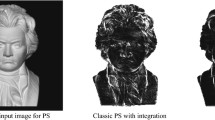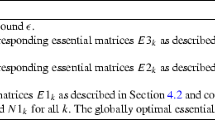Abstract
The restricted correspondence problem is the task of solving the classical stereo correspondence problem when the surface being observed is known to belong to a family of surfaces that vary in a known way with one or more parameters. Under this constraint the surface can be extracted far more robustly than by classical stereo applied to an arbitrary surface, since the problem is solved semi-globally, rather than locally for each epipolar line. Here, the restricted correspondence problem is solved for two examples, the first being the extraction of the parameters of an ellipsoid from a calibrated stereo pair. The second example is the estimation of the osculating paraboloid at the frontier points of a convex object.
Similar content being viewed by others
References
Birchfield, S., Tomasi, C.: A pixel dissimilarity measure that is insensitive to image sampling. Trans. Pattern Anal. Mach. Intell. 20(4), 401–406 (1998)
Bloomenthal, J. (ed.): Introduction to Implicit Surfaces. Morgan Kaufmann, San Mateo (1996)
Boykov, Y., Veksler, O., Zabih, R.: Fast approximate energy minimization via graph cuts. Trans. Pattern Anal. Mach. Intell. 23(11), 1222–1239 (2001)
Canny, J.F.: Finding edges and line in images. Master’s thesis, MIT AI Lab (1983)
Collings, S.: Frontier points: theory and methods for computer vision. PhD thesis, University of Western Australia Schools of Mathematics and Statistics and Computer Science and Software Engineering (2007). www.maths.uwa.edu.au/~scolling/Thesis
Collings, S., Kozera, R., Noakes, L.: Shape recovery of a strictly convex solid from n-views. In: Proceedings of the International Conference Computer Vision and Graphics, pp. 57–64, Warsaw, Poland (2005)
Collings, S., Kozera, R., Noakes, L.: Surface properties from n-views of a strictly convex solid. Fundam. Inf. 72(4), 437–452 (2006)
Collings, S., Noakes, L., Kozera, R.: Recognising algebraic surfaces from two outlines. J. Math. Imaging Vis. 30(2), 181–193 (2008)
Cross, G.: Surface reconstruction from image sequences. PhD thesis, University of Oxford, Department of Engineering and Science (2000)
Cross, G., Zisserman, A.: Quadric reconstruction from dual space geometry. In: Proceedings of the International Conference on Computer Vision, pp. 25–31, Bombay, India. IEEE (1998)
Faugeras, O., Hotz, B., Mathieu, H., Viéville, T., Zhang, Z., Fua, P., Théron, E., Moll, L., Berry, G., Vuillemin, J., Bertin, P., Proy, C.: Real time correlation based stereo: Algorithm implementations and applications. RR-2013, INRIA, (1993). http://perception.inrialpes.fr/Publications/1993/FHMVZFTMBVBP93
Faugeras, O., Kerivan, R.: Variational principals, surface evolution, pde’s, level set methods and the stereo problem. Trans. Image Process. 7(3), 336–344 (1998)
Faugeras, O.: Three-Dimensional Computer Vision. MIT Press, Cambridge (1993)
Fisher, R., Dawson-Howe, K., Fitzgibbon, A., Robertson, C., Trucco, E.: Dictionary of Computer Vision and Image Processing. Wiley, New York (2005)
Fitzgibbon, A., Pilu, M., Fisher, R.B.: Direct least squares fitting of ellipses. Trans. Pattern Anal. Mach. Intell. 21(5), 476–480 (1999)
Forsyth, D.A.: Recognizing algebraic surfaces from their outlines. Int. J. Comput. Vis. 18(1), 21–40 (1996)
Geusebroek, J.M., Burghouts, G.J., Smeulders, A.W.M.: The Amsterdam library of object images. Int. J. Comput. Vis. 61(1), 103–112 (2005). http://staff.science.uva.nl/~aloi/
Giblin, P.J., Weiss, R.S.: Epipolar fields on surfaces. In: Proceedings of the European Conference on Computer Vision. LNCS 800, vol. 1, pp. 14–23. Springer, Berlin (1994)
Gonzalez, R.C., Woods, R.E.: Digital Image Processing. Prentice Hall, Englewood Cliffs (2002)
Himmelblav, D.M.: Applied Nonlinear Programming. McGraw-Hill, New York (1972)
Kanade, T.: Development of a video-rate stereo machine. In: Image Understanding Workshop, pp. 549–557 (1994)
Karl, W.C., Verghese, G.C., Willsky, A.S.: Reconstructing ellipsoids from projections. Graph. Models Image Process. 56(2), 124–139 (1994)
Lucas, B.D., Kanade, T.: An iterative image registration technique with an application in stereo vision. In: Proceedings of the International Joint Conference on Artificial Intelligence (1981)
Ma, S.D., Chen, X.: Reconstruction of quadric surface from occluding contour. In: Proceedings of the International Conference on Pattern Recognition, pp. 27–31. IEEE (1994)
Marr, D., Hildreth, E.C.: Theory of edge detection. In: Proceedings of the Royal Society, vol. B, pp. 187–217 (1980)
Marsden, J.E.: Elementary Classical Analysis. Freeman, San Francisco (1974)
Millman, R.S., Parker, G.D.: Elements of Differential Geometry. Prentice Hall, Englewood Cliffs (1977)
Otten, R.H.J.M., van Ginneken, L.P.P.P.: The Annealing Algorithm. Kluwer, Boston (1989)
Polak, E.: Optimization: Algorithms and Consistent Approximations. Springer, New York (1997)
Porill, J., Pollard, S.: Curve matching and stereo calibration. Image Vis. Comput. 9(1), 45–50 (1991)
Rieger, J.H.: Three-dimensional motion from fixed points of a deforming profile curve. Opt. Lett. 11(3), 123–125 (1986)
Robert, L., Deriche, R.: Dense depth map reconstruction: A minimization and regularization approach that preserves discontinuities. In: Proceedings of the European Conference on Computer Vision, pp. 439–451. Springer, Berlin (1996)
Roy, S.: Stereo without epipolar lines: A maximum flow formulation. Int. J. Comput. Vis. 34(2/3), 147–161 (1999)
Scharstein, D.: Matching images by comparing their gradient fields. In: International Conference on Pattern Recognition, vol. 1, pp. 572–575 (1994)
Scharstein, D., Szeliski, R., Zabih, R.: A taxonomy and evaluation of dense two-frame stereo correspondence algorithms. Int. J. Comput. Vis. 47, 7–42 (2002)
Seitz, S., Dyer, C.M.: Photorealistic scene reconstruction by voxel coloring. Int. J. Comput. Vis. 35(2), 1–23 (1999)
Serra, J.: Image Analysis and Mathematical Morphology. Academic Press, San Diego (1982)
Shashua, A., Toelg, S.: The quadric reference surface: theory and applications. Int. J. Comput. Vis. 23(2), 185–198 (1997)
Sneddon, I.N.: Elements of Partial Differential Equations. McGraw-Hill, New York (1957)
Sun, J., Zheng, N.-N., Shum, H.-Y.: Stereo matching using belief propagation. Trans. Pattern Anal. Mach. Intell. 25(7), 787–800 (2003)
Szeliski, R.: Prediction error as a quality metric for motion and stereo. Int. J. Comput. Vis. 2, 781–788 (1999)
Teutsch, C., Berndt, D., Trostmann, E., Weber, M.: Real-time detection of elliptic shapes for automated object recognition and object tracking. In: Proceedings of Machine Vision Applications in Industrial Inspection XIV, Electronic Imaging 2006, 15–19 January 2006, San Jose, California, USA, pp. 171–179. SPIE/IS&T (2006)
Vogiatzis, G., Favaro, P., Cipolla, R.: Using frontier points to recover shape, reflectance and illumination. In: Proceedings of the International Conference on Computer Vision, pp. 228–235, Beijing, China. IEEE Computer Society (2005)
Xie, Y., Ji, Q.: A new efficient ellipse detection method. In: Proceedings of the International Conference on Pattern Recognition, vol. 2, pp. 957–960 (2002)
Zitnick, C.L., Kanade, T.: A cooperative algorithm for stereo matching and occlusion detection. Trans. Pattern Anal. Mach. Intell. 22(7), 675–684 (2000)
Zwillinger, D.: CRC Standard Mathematical Tables and Formulae, 31st edn. Chapman and Hall/CRC, London (2003)
Author information
Authors and Affiliations
Corresponding author
Rights and permissions
About this article
Cite this article
Collings, S., Kozera, R. & Noakes, L. Robust Surface Fitting from Two Views using Restricted Correspondence. J Math Imaging Vis 34, 200–221 (2009). https://doi.org/10.1007/s10851-009-0142-5
Received:
Accepted:
Published:
Issue Date:
DOI: https://doi.org/10.1007/s10851-009-0142-5




